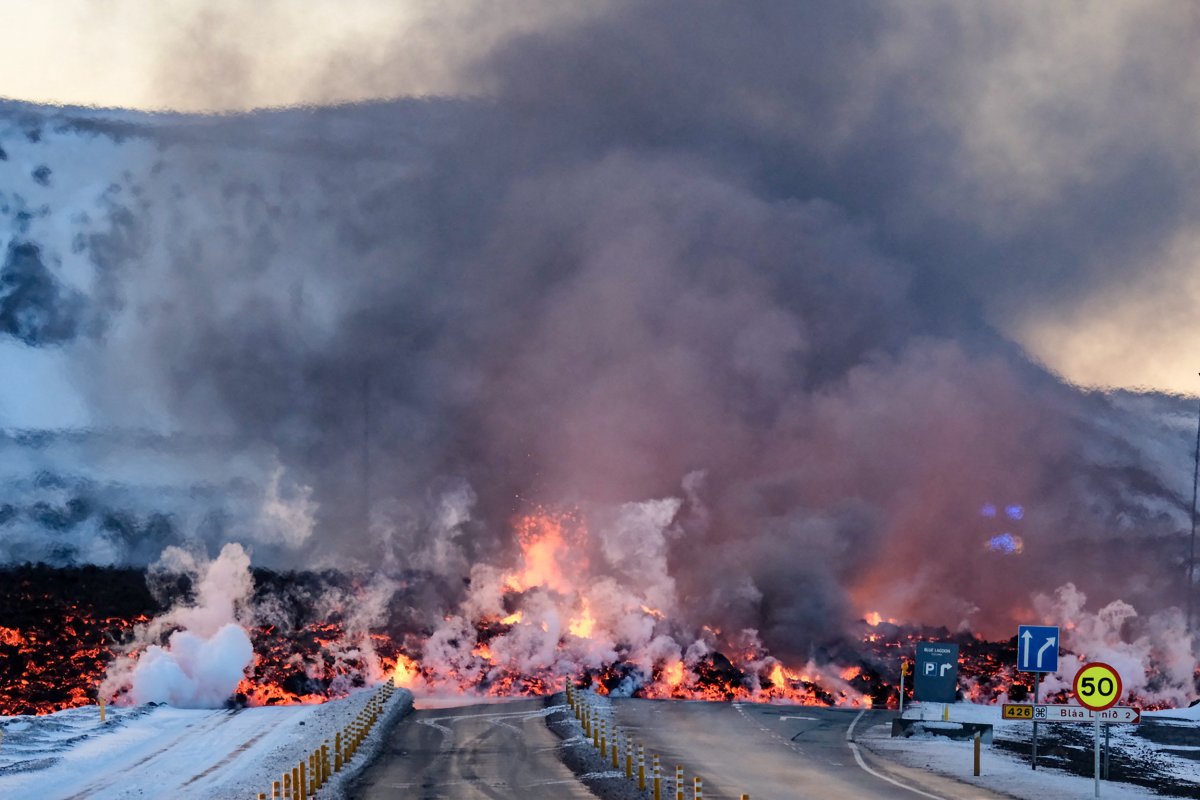A huge river of underground magma responsible for the recent eruptions at Iceland's Reykjanes peninsula flowed much faster than scientists initially thought.
The 9-mile-long magma dike, as the underground reservoirs of magma are known, reached a flow rate of 7,400 cubic meters per second, or about 261,328 cubic feet per second.
This is an unprecedented subsurface magma flow rate, according to a new paper in the journal Science.

"Our inferred peak magma flow rate of 7400 m3/s is two to three orders of magnitude larger than in the 2021, 2022, and 2023 eruptions in the nearby Fagradalsfjall area," the authors wrote in the paper. "The flow rate is also larger than in the 2014 to 2015 Bárðarbunga events, when a total of [about] 2 km3 of magma were emplaced partly in a 48-km-long dike that formed over two weeks and partly erupted with an initial inferred magma flow rate of ~240 m3/s"
"The peak flow rate in the Grindavík dike is comparable to inferred average eruption rate in the first 12 days of the massive 1783 to 1784 Laki eruption when 14.7 km3 erupted in total, during a nine-month period"
Magma dikes can transport molten rock to the Earth's surface, allowing it to break through the crust and become a volcanic eruption. This magma dike is the driver of the December 2023 and January 2024 eruptions across the Reykjanes peninsula, the latter of which occurred right on the outskirts of the fishing town of Grindavík. Rivers of lava poured into the evacuated town, setting fire to several of the houses.
"In November 2023, a 15km long magma dike propagated beneath the town of Grindavík, Iceland, causing widespread damage and evacuation. The dike formation was followed by fissure eruptions on 18 December 2023 and 14 January 2024, with lava flowing into Grindavík," Sigrún Hreinsdóttir, a geodetic scientist at GNS Science, a New Zealand-based geology, geophysics, and nuclear science research institute, said in a statement.
"Using satellite-based geodetic observations and seismic measurements researchers show that the dike reached an ultra-rapid subsurface magma flow rate of 7400 cubic meters per second. The study demonstrates that fracturing and tectonic stress are important factors in dike formation and imply a high hazard potential for intrusions that propagate to the surface, leading to eruptions."

This indicates that pressure isn't the only major driver behind volcanic eruptions, with tectonic stress and the tendency of the ground to crack and fracture being important factors in how much magma flows into a dike, and thus how likely a volcano is to erupt.
"Such high flow rates provide insight into the formation of major dikes," the authors wrote in the paper.
They also say that the high flow rate of the dike is likely influenced by the density of the lava being low beneath Iceland, making it more buoyant and more adept at flowing quickly through cracks in the ground.
"The buoyancy of magma, influenced by its density and the density of the surrounding rocks, along with its viscosity, can affect how and where it moves. Less viscous magma can more easily migrate through cracks and fissures in the crust," David Kitchen, an associate professor of geology at the University of Richmond who was not associated with the research, told Newsweek.
The researchers also note that this discovery implies that high flow rates into dikes at other volcanoes around the world could mean they are at risk of major eruptions.
"Our findings have implications for magmatic activity in other parts of the world where extensional processes gradually lower the minimum compressional stress in the crust, such as along the mid-oceanic ridges of the world, and Afar (East Africa)," the authors wrote.
The same magma dike likely also caused the third eruption near Grindavík in as many months, with lava beginning to spew from a new fissure early on February 8, 2024. According to the Icelandic Meteorological Office, the new eruption sent spurts of lava shooting several hundred feet into the air.
Do you have a tip on a science story that Newsweek should be covering? Do you have a question about volcanoes? Let us know via science@newsweek.com.
Uncommon Knowledge
Newsweek is committed to challenging conventional wisdom and finding connections in the search for common ground.
Newsweek is committed to challenging conventional wisdom and finding connections in the search for common ground.
About the writer
Jess Thomson is a Newsweek Science Reporter based in London UK. Her focus is reporting on science, technology and healthcare. ... Read more





